Introduction
If you have been in marketing for a while, you have probably come across the term ‘Marketing Mix’ or its informal name, the 4Ps. Marketing Mix was coined in the 1960s by Neil Borden, an American professor, and academic.
The 4Ps are the foundation of a lot of modern marketing fundamentals, strategies, and concepts. Although they were made over 50 years ago, they are still very relevant in a modern-day setting.
In this guide, we will be looking at the 4Ps of Marketing (Marketing Mix), and showing why each part of it is so important to your marketing strategy. We will also be exploring the 7Ps, which is a more modern update on the original framework.
What Are The 4Ps Of Marketing?
Understanding the importance of this model is vital to succeeding, and moving forward in your business, but first, you have to know what each of the 4Ps is.
There is no denying that there is a multitude of different tools that organizations can utilize to improve their business, but it could be argued none are as simple and effective as the 4Ps of Marketing.
The 4Ps are Product, Price, Place, and Promotion. Each of these is a different part of your overall marketing and will help you determine a lot of elements of your business, and strategy.
All of the 4Ps of Marketing are connected and flow into each other. Successfully implementing just one area is not enough to make it work, all 4 of the Ps need to be addressed, and given equal priority.
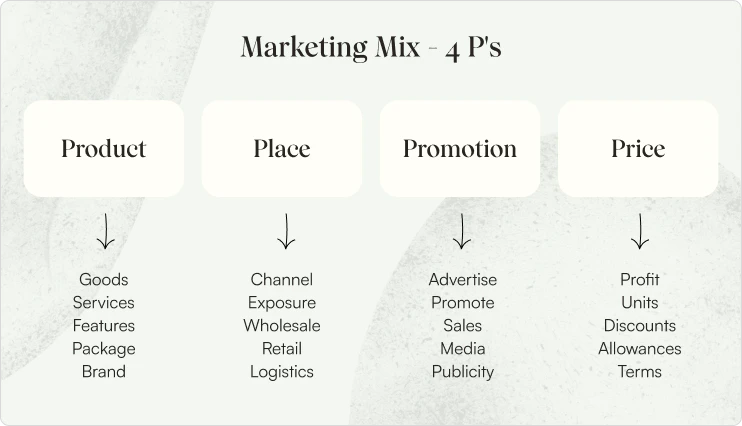
PRODUCT
This is what you sell, this can be a physical product, a service, a digital asset, or anything that the customer buys from you. For simplification, we will be using the term Product for all of these things, but it covers a wide array of things.
Your product is what you make available to your customers to buy. In terms of the 4Ps, this is understanding exactly what you are offering your buyers, and how you can separate yourself from your competitors.
Traditionally speaking, your product should be a solution to existing customer demand. However, as we evolve, and technology changes, products can create a new demand entirely.
Understanding that each product has its own lifecycle is important to how you market, where and how you sell, and the amount of money you need to raise awareness about it.
As you’ve probably heard before, it is important to have a Unique Selling Proposition (USP). You need to determine what makes your product so unique, why should people buy from you, and not your competitors.
WHAT IS YOUR USP?
A Unique Selling Proposition is exactly what it says on the tin, it is how you are different, be that your company, your staff, or your product.
Working out what makes you different is the key to unlocking your company’s full potential. What makes you stand out? Why should customers buy from you? What can you offer that no one else can?
Your USP could be anything, as long as it sets you apart from everyone else. Maybe it’s your superior product, your commitment to the environment, or your motivated staff.
Knowing your USP is a fundamental part of your business. Understanding its significance, and importance will help you package up your organization as a whole, and in turn, will be part of your ‘Product’.
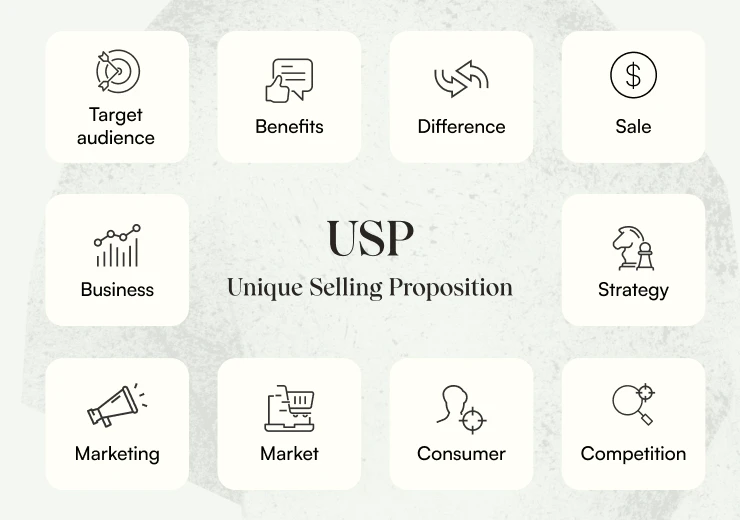
QUESTIONS TO CONSIDER FOR YOUR PRODUCT
What is our customer’s biggest pain point? – Once you know what the problem they want to fix is, you can ensure you target, market, and design your product around the solution.
Can we improve our product? – Think about how you can improve your product, it’s highly unlikely you have got the perfect thing on version 1.0. Look to improve, and adapt as the market changes.
What is our competition doing? – Understanding what your competitors are doing, and how they market their products is vital to developing a winning approach. Look at what they are doing well, and try to evolve that concept.
What don’t we like about our competitors’ products? – Competition gives you invaluable feedback if utilized correctly. Think about not only what you like about their products, but what you do not like too. This will help you determine opportunities for growth, or areas to avoid.
What’s our long-term goal for this product? – Is this something that customers will buy once, and that’s the end of it? Or can you create a need for re-purchasing or subscriptions? The evolution of how we interact with companies has changed, so consider this in your product pitch.
PRICE
The second element of the 4Ps of Marketing is Price. What you set your price at will have a ripple effect throughout your business, and the wider marketplace.
It is fairly rudimentary to understand what this section of the Marketing Mix is about, but that does not mean it is easy to determine the right price.
Price has a big impact on both how customers perceive you, and how you perceive your product. You can probably think of loads of companies that pride themselves on providing the best price to the customers.
On the flip side, there are a lot of luxury brands who charge their customers much more but are seen as more exclusive, but also elitist.
Understanding the importance of price is not as easy as it seems on the surface, so let’s dive a little deeper into this part of the 4Ps of Marketing.

QUESTIONS TO CONSIDER FOR YOUR PRICE
Is there a standardized price point in the industry? – Knowing if there is a price that customers are prepared to pay for this sort of product or service is important to your pricing strategy. You will need to justify why you are priced higher, lower, or the same as this.
What is our competitor charging? – There are very few companies that do not take notes from their competitors. Having an intimate understanding of how much your direct, and indirect competitors are charging will help you determine your prices.
What value does our product bring? – You need to think about what your product can do for your customer, and the value they associate with it. Some are easier to determine, especially if something is more of a need than a want.
Are we going to offer discounts? – Correctly using discounts can be a great way to boost your business, and tempt new customers to buy your products. Although, some people associate discounts with lower value, so timing your price changes correctly is important.
What is the lowest price we are willing to charge? – Having a good idea of what your minimum selling price is will help you in a range of situations. Whether it’s in a negotiation, setting discounts, or determining price points, it is helpful to know this figure.
What does the market leader charge? – Understanding who is in control of the market, and the pricing strategies is good to decide on yours. Finding ways to differentiate your product will help you create your own niche, and customer base.
WHAT YOUR PRICE SAYS ABOUT YOU
High Price
Having a more expensive price tag for your product can be both a blessing and a curse. You might make more money off of each sale, but reach a lot fewer people.
This can alienate people, but also create a type of exclusivity. For some industries, this makes it more desirable, and for some, it can be to your own detriment.
Your stage in your business or product life cycle could have an impact on your price too. To put this into context, it may cost you a lot more per product at small volumes, but when you start making things at a larger scale, the price per unit drops significantly.
If you are offering something digital or virtual, be aware of the risks of charging a high price for your intangible goods.
Customers will often spend more money on a cause they feel passionate about, or if your business values align with their personal ones.
For instance, if you use fair-trade materials, or donate a portion of your profits to charity, or a good cause, they will be more willing to pay a premium.
Low Price
When you set a low price for your product, there are a few different things that people associate with you, let’s briefly look at what this could mean.
Potential buyers can see your product as great value or inferior to other ones on the market, it depends on a lot of factors, such as your industry, product type, and reputation.
The perceived value of your product can be lowered in the eyes of your customers if you price what you are selling too low.
Everyone will have a set value in their head that determines this value, if you are too far above or below it, they are unlikely to buy from you.
What might be deemed as a low price to one customer, may be expensive to another. Knowing your different markets, and target audiences are vital to choosing the right price, and approach.
Competitive Price
If you are priced right in the middle of the competition you run the risk of not being chosen by anyone. If you try to appeal to everyone, you can often end up appealing to no one.
This is exactly why knowing what the right price for your product is, this can be done by comparing to your competition, conducting research, or sometimes by trial, and error.
This showcases the importance of having target markets and understanding your customers. You need to know what price is both fair and profitable.
Although pricing similar to your competitors may seem like a good strategy, it depends heavily on your industry. For example, if you are selling milk that is comparable, charging twice as much is not viable.
Whereas if you have an innovation that differentiates your product from your competition, you can afford to price it higher.
The Right Price
The above are just some examples of how pricing incorrectly can jeopardize your product regardless of what you do. You need to tailor how your customers see your company, and the value your product brings.
This can be done through research to understand their buying behavior and mindset, or through savvy marketing plans, and campaigns to help build value.
Obviously, the price you charge is not completely in your control, and there are a lot of extraneous variables that affect your product. Often it can be a trial, and error, especially if you are new to a market.
The right price may not always be the same, you will need to think about changing conditions, economy, buyer opinions, and competition. Understanding that your price may be fluid is the core of determining the right end-cost.
In short, finding the right price is like the three bowls of porridge in Goldilocks, you often need the perspective of what does not work to get the right answer.
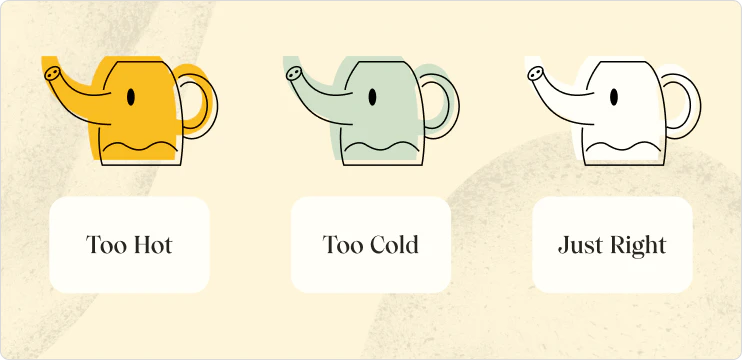
PLACE
The next of the 4Ps of Marketing is Place. Think of this as location, it is getting your product in front of the right customer, at the right time. It is about knowing their habits, where they like to shop, and how they like to shop.
Working out where your customers are makes your job a whole lot easier. Take for instance you are trying to reach millennials, you should try more heavy digital marketing, and utilize social media, it does not make sense to use traditional advertising like TV or Radio.
Sometimes the Place you need to focus on is where your best customers are, not just where the most are. Think about who provides your business with the most value, and focus on creating a loyal customer base, and work from there.
Picking the Right Place
Consider all of your options that might be the best Places to reach your customers, there may be one that you have wanted to explore for a while.
Even if you are a physical business with a brick & mortar store, your potential customers will likely be doing some research before they decide to visit your location.
Understanding the importance of having different options and places for your customers to buy or gather information is vital to this element of the Marketing Mix.
Some examples of Places you can sell are:
- Your website
- Specialist websites
- Brick & mortar store
- Retailer
- Wholesaler
- Digital Marketplaces (Amazon, eBay, etc.)
- Social media
- In-person
- Telesales
This is just scratching the surface of the different Places you can sell to your customers, or help them gather the information that will lead to their purchase.
Questions to Consider for Your Place
Where are our customers? – This is the core to Place, knowing where your customers are. Doing research will help you know where they are, how they act, and how to approach them. Having a broad strategy will not work, you have to target different groups uniquely.
Who do we sell to? – Basically, are you a B2B or B2C company? The two types have varying approaches, and the places you sell will be vastly different. This will affect the other elements of the 4Ps of Marketing too.
What are the competitors doing? – You can use this for both the good and the bad. Where are they succeeding? And where are they failing? As a rule of thumb, you should offer your products in the same places so that customers won’t automatically pick them as they sell online and you don’t.
What channels are working for us? – Analyzing where is being successful, and bringing in the most income is important. Think about your costs associated with different places. For example, rent is a costly expense, as opposed to running an online store, but if 90% of your sales happen in person, then it is worth it.
Where do we sell our products? – Think of this literally, and list the places you sell your products, be that online, offline, third-party, digitally, etc. Simply noting down the pros, and cons of each place you sell might help you determine which is working best. Running the numbers will help you narrow it down too.
Is there a channel we are not using, that we should? – This may be one that you wanted to venture into or just one you are completely lacking. With the sheer amount of ways to reach customers, there will always be one that you should be using. Think about which could be the most lucrative.
PROMOTION
The final P of the Marketing Mix is Promotion. Typically this is the order of the different parts, but they are all equally important.
Promotion is about getting sales using different tactics, and methods. It is about generating revenue from your products. This 4th P is about determining the need for your product, creating consistent demand for it, and persuading customers to pay X price for it.
In the digital age, it can be harder to distinguish the differences between Place and Promotion, and sometimes they are happening concurrently. For instance, you might have a website that both promotes your products, and gives information to the user to help their decision.
The important thing to note is that you do not have to think of each of the 4Ps of Marketing as their own entity, but four pieces to a larger puzzle. Overlapping these elements is not a bad thing, in fact, it’s exactly how they were designed.
TYPES OF PROMOTION
Let’s take a look at some examples of promotion types, and what they are. This is not a definitive list but gives you an idea of how many different types of Promotion come under this element of the 4Ps of Marketing.
Social Media – understanding and utilizing social media in a contemporary marketing environment is important. Promotion via social media can set you apart from your competitors, and with the majority of companies underusing these platforms, is key to get right.
Personal Selling – think of this as anything that is face-to-face or via the telephone. It is when the customer is speaking directly to the salesperson. If you are B2B this is talking to the decision maker or someone with purchasing power, for B2C it’s speaking to the end-user.
Direct Marketing – this is used less and less, but if done correctly, can still be a valuable promotion tool. This is when you reach out directly to your potential customers. The most common example is mail marketing, such as sending a leaflet or flyer to prospective customers. Typically this is unsolicited.
Sales Promotion – possibly the most widely known form of promotion, this is implementing short-term sales or discounts as an incentive to spur a purchase. This can work both as a catalyst to speed up their decision, or invite an impulse decision to get a good price.
Advertising – this can be simplified as the use of paid promotions delivered via mass media sources. These provide the same message to everyone who sees it, so is seen as impersonal, but can work for broader messaging or awareness.
Public Relations – PR is the use of non-paid media to attract attention to your brand and promote your business. There are a lot of methods to gain press, from reaching out to influential news sources to hosting a press conference, to media day previews.
Sponsorship – you can probably think of countless instances of sponsorship, and the practice has been done for decades. Normally people associate it with a name/logo on a sports kit or an event sponsor. You are effectively buying space to promote your brand in the public eye.
Digital Promotion – an incredibly broad category, but a very influential one, digital is imperative to have within your promotional toolkit. Regardless of your industry, you will likely have a digital footprint, even if it’s fairly rudimentary.

QUESTIONS TO CONSIDER FOR YOUR PROMOTION
What types of messages work the best? – Working out what the best angles and approaches are will give you a good feeling for your messaging. Take for instance your customers love a sale, then sending out a promotional email advertising it is likely to work.
Do you have a seasonal product? – If you have something that gets a large increase in sales at a certain time of year, you have a seasonal product. If promoted correctly, this can be a cash cow and give you revenue every season. You can’t typically rely on this, but having one in your arsenal is very useful.
What are the competitors doing? – As with the other parts of the Marketing Mix, you need to keep an eye on your competition. How are they promoting their products? What message are they using? Competitors give you a good baseline to work off of.
When is the best time to promote our products? – Similar to seasonality, there are certain times when your products may be better to promote. Understanding the buying behavior and patterns that your customers exhibit will help you determine this.
Where should we promote more heavily? – Utilizing data, and analytics will help give you a clearer picture of where you should focus your efforts. Steer away from the ‘if it ain’t broke don’t fix it’ mentality, and look for where will be the most lucrative.
What promotion works on what channels? – Just because something works well in person, does not mean it will transfer to online success, and vice versa. Knowing how to promote on different channels will open up a lot more doors for your business.
What Are The 7Ps Of Marketing?
It took almost two decades before the 4Ps were extended into the 7Ps of Marketing. This comprised the original 4Ps, plus 3 additional ones, Physical Evidence, People, and Processes.
In marketing, things tend to move and evolve pretty quickly, so it was inevitable that this framework was going to be updated at one point.
The inclusion of the additional 3Ps provides more insight for marketers, and businesses, in a more contemporary setting.
We are going to look at each of these additional parts of the Marketing Mix, and their importance within the marketing world.
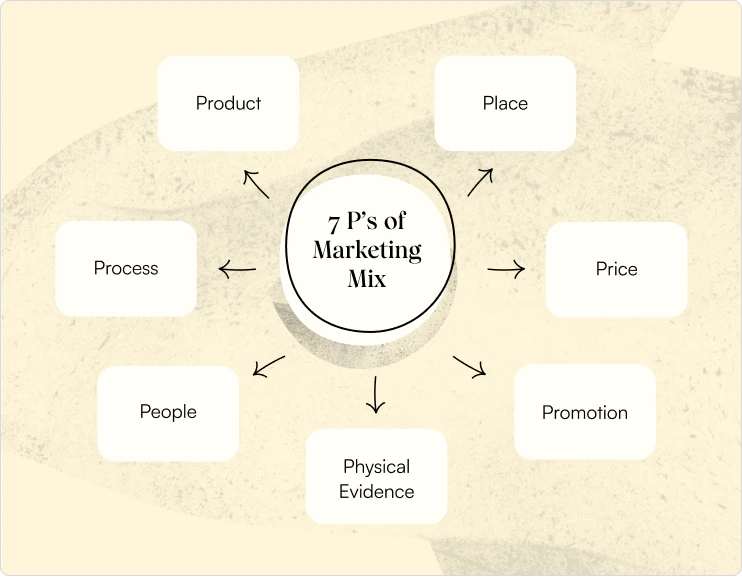
PHYSICAL EVIDENCE
As the name suggests, Physical Evidence is the ways your business proves that it is both legitimate, and someone customers want to do business with.
This typically can be simplified into two areas, evidence of your existence as a brand, and proof that a sale took place.
Physical Evidence can be anything from the tangible product to proof of purchase (like a receipt), tracking information, and confirmation emails.
This may seem like fairly rudimentary information, but it is invaluable to your customers and will set you apart from the competition.
Take, for instance, one of your competitors has the same product as you but has excellent customer service and a ton of physical evidence. Your customers will deem them as a superior company, and by association, the product will be seen as better than yours too.
Ensuring your customers trust you, and do not have any reservations when buying from you is core to succeeding at this part of the Extended Marketing Mix.
Physical Evidence can come in a lot of different forms let’s look at a few:
Receipts
This is the proof of purchase and makes people buying your product or service feel a lot more comfortable. They have an assurance that the sale took place, and that they have the power to contest the sale if there are any issues.
Even though this may seem like a simple thing, it is often overlooked by newer businesses and certain industries. Making sure you have some form of proof of purchase is vital to cementing your company as a viable entity.
Reviews & Testimonials
Knowing what other people and clients think about your business is an important part of the buyer’s journey for your potential customers. The amount of research people will do before buying your product or service is fairly large.
Ensuring you have some form of reviews, testimonials, or references from your current paying customers is vital to getting new business. It is a form of social proof that people look for when purchasing from a new company.

Social Presence
Building a social media following does not have to be your top priority, and it will happen fairly organically if you have designed a decent social media strategy.
With this being said, having a social presence, and a dedicated team or person to look after it is vital to moving your company forwards. Being active on social media, engaging your followers, and posting regularly are just a few simple steps to improve your Physical Evidence.
Physical Location
Despite the rise of remote working and virtual offices, customers will feel much more comfortable if you have a physical office, or are at least legally registered somewhere.
You would be surprised how many people will review your ‘about us’ or ‘contact us’ page before making a purchase.
PEOPLE
The next update to the Marketing Mix is People. This can be viewed as both internal, or external people, and stakeholders in your business. However, in terms of the 7Ps, the focus is more on your people, your staff, and things you can control.
To put it briefly, think of ‘People’ as anyone who is either directly, or indirectly, part of the business side of your organization.
Having the right team for the job is critical for succeeding in your strategy, and in your marketing. You need to consider who is coming into contact with your customers at every point of their journey.
You could have a world-changing product or service, but without the right team behind it, your dream will never become a reality. One of the hardest things for a small business to do is scale effectively, keeping the same level of passion, and enthusiasm as it grows.
Think about who is the first person they meet, the ease of contacting customer services, and the sales staff who are persuading them to buy from your company.
Every single person is different, so it is through training, motivation, and achievement that people can excel and be an asset to your organization.
Having the right people for the job can be your ‘X Factor’, your point of differentiation. You can diversify from your competitors by having the best staff, and giving each customer tailored support and assistance.
Retaining Staff Tips
Having team members that are motivated, and committed to your company long-term can be a huge asset. Gone are the days when people stay at one company their whole career.
If someone feels they are being unvalued or can get better progression somewhere else, they will be out the door. Below are just a handful of tips you can consider when trying to retain your staff, and keep them happy.
- Hire on potential, not just experience
- Provide lots of onboarding, and support
- Engage your employees
- Celebrate their success
- Provide tangible benefits and incentives
- Pay your staff well
- Be open to new ideas, and their perspective
- Determine their goals, and help your staff meet them
Building long-term relationships with not only your customers, but your staff too is the key to succeeding in this area of the Marketing Mix.

PROCESS
Think of this as the final piece of your Marketing Mix puzzle, and the definition of this part of your marketing is very literal. ‘Process’ is the steps or actions you take to get your product or service to your customers.
You will need to access each part of your sales funnel, buyer journey, and operation. This will help you determine not only how your business will operate, but if there are any weak links or areas for improvement.
This section is not solely about the actual processes and what they are, but the way you can adapt, and improve them to create a better overall experience for your customer. Ironing out different issues, reducing costs, or finding better ways to operate is all part of this 7th P.
Ensuring you have a smooth, and logical customer journey is hard to achieve if you do not have the correct processes in place. Each business will have its own actions that they need to take, and there is no one-size-fits-all solution.
There are a lot of ways you can review your Processes and different tools which can help you make them easier. Let’s look at an example of a Process tool.
Workflows
Mostly used in email marketing, workflows can be utilized in a lot of areas of your marketing and business. Put into context, a workflow is a series of actions that are triggered by an event.
For instance, if someone signs up for your mailing list, that is the action, this will trigger a set of timed dominos to fall over. After ‘X’ amount of time they will get a follow-up or confirmation email, then maybe in 2 weeks, they get a promotion or offer, or they get the monthly e-newsletter.
This is all part of your workflow, and you can utilize this process to develop how you approach different elements of your business from customer service to sales to marketing.
How Do You Use The 4Ps?
If you use the 4Ps correctly you will be able to effectively differentiate yourself from your competitors, and carve out a place in the market for your company to thrive, and grow.
Ensuring you can provide something different, and something better is the key to succeeding in a crowded marketplace.
The 4Ps of Marketing give you a rough outline for how to approach different areas of your business and will help you hone your strategy. Each of the Ps will give you a different perspective on your marketing.
Finding a way to be unique, and resonate with your customers and potential buyers in the essence of marketing, and the 4Ps.
Why Were The 4ps Made?
Determining the purpose of the Marketing Mix can help a lot of businesses make the leap to developing their own response to the 4Ps of Marketing.
The 4Ps were initially created over a series of years by a range of different experts, marketers, and academics. The base goal was to support the development of a successful marketing strategy.
This framework would allow businesses of any size to conduct research, and with a customer-centric focus, allow them to achieve their goals.
When utilized properly, and fully understood, the 4Ps of Marketing have proven time, and time again that they are a factor in business success, and overall marketing strategy.
Key Features Of The 4Ps
The Marketing Mix is a tool that has been commonplace in the world of marketing for decades, due to the simplicity, and scalability of its design. Anyone from an entrepreneur, to a multinational organization, can benefit from working through the 4Ps.
This section is going to briefly look at some of the key features of the 4Ps of Marketing, and contextualize them within a business setting.
FLEXIBLE TO SUIT YOU
The 4Ps are a very fluid concept that is designed to be flexible for the company that is working on them. The grounding is the same, but how each company approaches the framework and implements it into their organization is down to them.
Finding prompts, and gaining inspiration from other companies, and sources is typically a great way to start, but the end result for every organization will be completely unique to them.
As every business is different, so will every iteration of the 4Ps of Marketing. In fact, even if you were to conduct another analysis using the Marketing Mix a year later, you would have a completely different set of information, and results.
CAN HELP YOU ACHIEVE MARKETING GOALS
The 4Ps are not a magic potion, and will not automatically make your business an overnight success.
However, if used correctly, they can put you well on your way to achieving your business goals in the mid-to-long term.
When you have properly researched, and implemented the 4Ps strategy in your business, the sky’s the limit, from improving sales to increasing retention to reducing costs, and more.
OVERLAPPING VARIABLES
The beauty of the 4Ps is that they operate as 4 parts of the same machine, your business. None of them is moving without impacting another. Each area is interdependent on the rest.
Determining your strategy will be an effort on all 4 fronts, ensuring each part of your Marketing Mix is moving forward, and being addressed.
This can seem daunting, but it presents a lot of opportunities. The 4Ps can be complementary pieces, that if aligned correctly, can propel your business forwards.
CUSTOMER-FOCUSED
One of the features that make this framework so effective, and widely used is the fact that the customer is the focal point for each of the 4Ps of Marketing.
Unlike other methods and tools, this is designed to be customer-centric and understands that without people buying your product, you do not have a business.
Considering the customer’s point of view at all parts of your process will allow you to get much more reliable, and tangible results. This can be through research, data, or analytics.
EVOLVING NOT STATIC
An important thing to remember is that the Marketing Mix is not set in stone, the 4Ps are designed to be flexible, and adapt to changes in the business environment.
As we alluded to above, conducting a second attempt of this model, let’s say a year later, will yield massively different results, because of a range of internal, and external variables.
Understanding that it is an evolving, and fluid method will allow you to thrive, and reach your business goals. The 4Ps of Marketing provides a useful stepping stone for any size business to determine where they are at, where they have been, and where they are going.
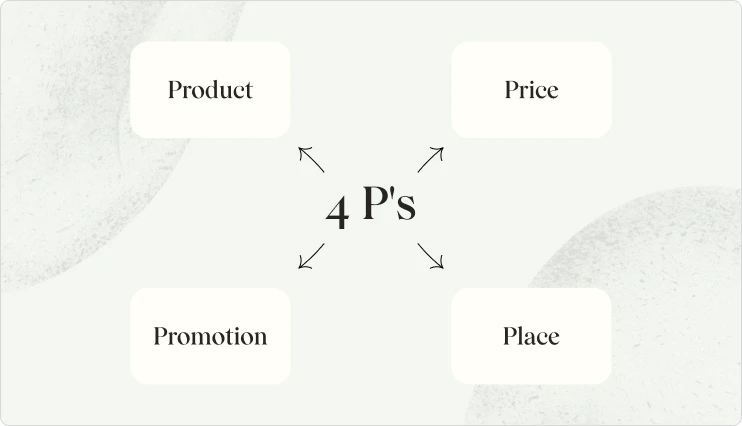
Desired Outcome
If you address each of these elements of the Marketing Mix within your organization, you will provide yourself with a much better chance of success, now, and in the future.
Each of the 4Ps will help dictate your strategy and give you a better guide on how to approach different areas of your business.
Once you pair this framework with other tools and tactics, you will be in a much better position to sculpt your company into the business you want.
4Ps Of Marketing Summary
Hopefully, you will now have a newfound appreciation for the Marketing Mix, and 4Ps of Marketing.
These will give you the building blocks to ensure you have considered the important factors in both your business and your marketing strategy.
The inclusion of the additional elements that make up the 7Ps of Marketing further improves upon the framework and will allow you to address extra parts of your business.
Understanding, and implementing each of the different aspects of this helpful acronym will allow you to move closer to success. Considering each of these parts of the Marketing Mix will help you create a streamlined strategy, and approach to your marketing.














.webp)

.webp)








.webp)










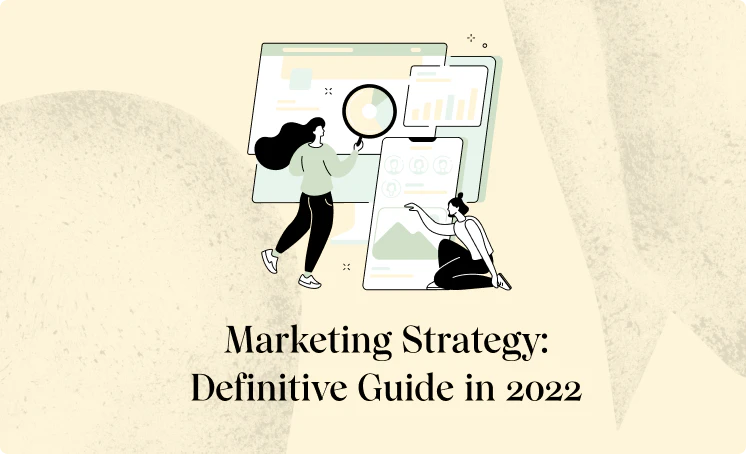






























.webp)






